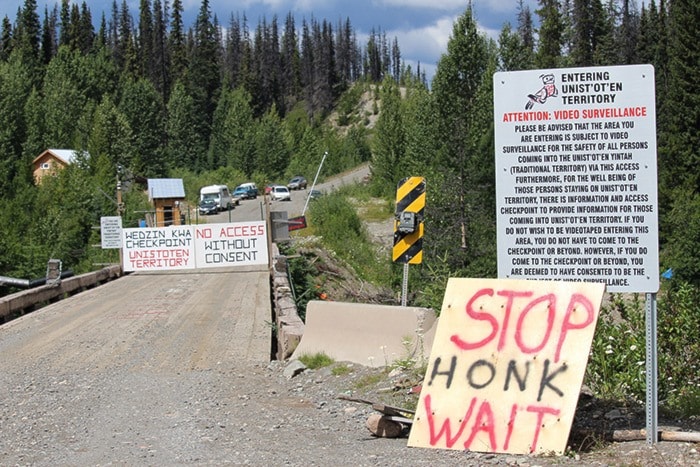When you visit the Unist’ot’en camp 66 kilometres south of Houston, you may not get to stay.
You will stand at the checkpoint, wait, and then answer questions. If you are from industry or government, if your presence involves an intention to do surveying or drilling work in the territory beyond the camp, or if you are unable to state how your visit will benefit the Unis’to’ten people, you will probably not receive consent to move forward across the Morice River bridge on the Morice West forest service road.
Unist’ot’en territory across the Morice River
The bridge is being held by representatives of the Unist’ot’en territory. Their first line of defence in withholding consent is their historical claim on the land. Their second is the 1997 Delgamuukw decision in the Canadian Supreme Court, which was signed by 35 Gitxsan and 13 Wet’suwet’en hereditary chiefs. One of those hereditary chiefs is Kneadebeas.
“Kneadebeas is my head chief,” said Freda Huson, appointed spokesperson for the chiefs of the Unisto’ot’en people. “The two prior Kneadebeas were my grandmother and my aunt. My aunt is the one whose oral testimony was proven in the courts (in the Delgamuukw case).”
“We are basically monitoring the land,” said Huson. “That’s been part of our tradition for thousands of years. People had to gain consent.
“Most times we do grant permission. We let berry pickers in and we let people come to fish or camp. The only reason we have to do things this way is because we have industry landing choppers (in our territory) even though we told them they don’t have our consent; they kept trying to sneak in.”
Freda and her husband Toghestiy have lived on the Unist’ot’en side of the bridge since 2010. They crossed it together several times last week as about 30 people arrived to attend the seventh annual Unist’ot’en action camp. They turned no one away, including a reporter from the Smithers Interior News.
Evolving from camp to community
After hearing Freda speak about the significance of the Morice River to salmon populations across the Northwest, crossing the bridge brings you to the hub of the camp with several new structures. These include a bunkhouse, a kitchen and meeting house, and a three-story healing centre under construction as the second part of a three-phase project.
The well-documented Unist’ot’en refusal to allow pipelines through their territory remains a key focus, with a new theme chosen for this year’s action camp.
“The way that we’ve been running our action camps since the beginning has been to train people in direct action techniques in the protection of the land,” said Toghestiy.
“We wanted to evolve and move into marketing. We want to get the message out to show that our camp is not confrontational and has never been confrontational, but we are also focusing on defensive factors that come into play whenever we are dealing with industry and government forces,” he said.
- Read the full version of part one in the June 20 edition of The Interior News.
Read part two in the upcoming June 27 edition.

